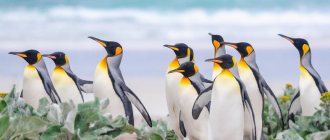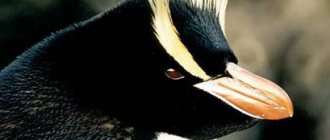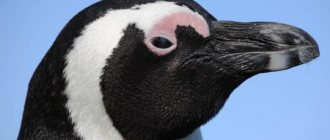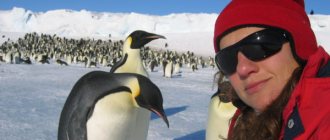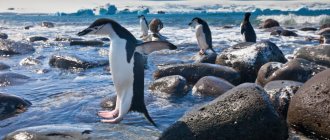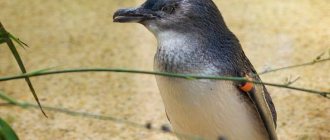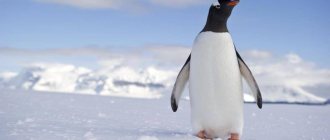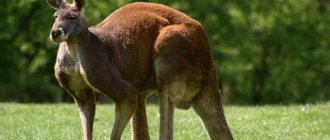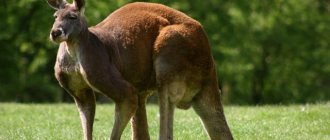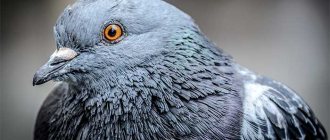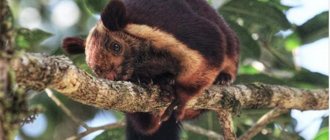So, where do they live, these same penguins? Many of us, sometimes even for a minute, still have doubts: where in the Arctic or Antarctic? But there should be no doubt - penguins live only in the Southern Hemisphere, which means in Antarctica.
Penguins are not flying birds, clumsy on land, but excellent swimmers, capable of swimming vast distances of tens and even hundreds of miles. Thanks to this, penguins live not only on the coast of Antarctica, but also on numerous sub-Antarctic islands that they have chosen to live. Their habitat is a very large area. Some species of penguins live on other continents, in Australia, New Zealand, South America and even Africa. Moreover, each species is located separately for nesting in places where they have established their colonies since ancient times. But first things first, we will try to explain in detail where and what penguins live.
Where do Emperor penguins live?
The Emperor Penguin or Foster's Penguin is the largest of all penguin species. His height reaches 122 cm, and weight up to 45 kg. The plumage of this penguin is black on the back, white on the chest, and yellow-orange on the neck and cheeks. Emperor penguins live further south than all the others.
Emperor penguins live on the coast of the mainland and on ice floes around Antarctica; they all migrate to the mainland to mate and hatch eggs. It is believed that there are 34 colonies in the world, although in 2009 38 wintering sites were noted. The total number of living emperor penguins is difficult to determine due to the inaccessibility of most nesting sites, but on average it is about 500 thousand individuals.
Lifestyle
The most interesting feature regarding the lifestyle of these birds is the fact that matriarchy dominates penguin society. It is the female penguins who choose the males they like, care for them, seek their recognition, then the males, in turn, hatch the eggs, while the females get food. In general, the roles of gender relations in penguins are diametrically opposed to many other representatives of the animal world.
Penguins are collective creatures and do not just live in families or flocks, but form entire bird colonies that can reach up to a million individuals. And on Zavadovsky Island, located in the South Atlantic, the world's largest colony of chinstrap penguins is known; according to rough estimates, about 10 million of these birds live there.
Penguins love to be in the company of their own kind, but during the mating season for procreation, the male and female temporarily leave the company of their relatives and return back with a newborn baby, but we will write about this in more detail below.
Where do king penguins live?
King penguins are very similar to emperor penguins, but they are smaller in size and their colors are brighter. The body length of a male king penguin is up to 1 m. King penguins have a gray back, a white belly, a black head with orange spots on the sides and on the chest.
King penguins live and nest mainly on the islands: Tierra del Fuego, South Georgia, Macquarie, Crozet Islands, South Sandwich Islands, Prince Edward, Kerguelen, Heard. The population is about 1 million pairs.
Where do crested penguins live?
The crested or rocky golden-haired penguin belongs to the genus Crested penguins. This is one of the small penguins. Its height is about 55-62 cm, and its weight is from 2 to 3 kg. The color is bluish-black above and white below. The wings are narrow and look like flippers. The eyes are small. On the head, on the top of the head, black feathers grow, from the eyebrows there are bright yellow feathers ending in tassels.
Crested penguins live on the islands of the Subantarctic, Tasmania and Tierra del Fuego, and are found on the coast of South America. The population is about 3.5 million pairs.
Bird distribution
Marked places on the map where penguins live
Penguins are common in the open seas of the Southern Hemisphere (coastal waters of Antarctica, New Zealand, southern Australia, South Africa, on the coast of South America from the Falkland Islands to Peru, on the Galapagos Islands).
These birds prefer cool climates, so they can appear in tropical latitudes only with cold currents
The warmest place where penguins live is the Galapagos Islands, which are located near the equator.
Where does the golden-haired penguin live?
The golden-haired penguin is another representative of the genus of crested penguins. The British call him Macaroni Penguin, which means dandy penguin, for his unusual hairstyle. They have a dark back, an almost black head and a white belly. Above the eyes of these penguins grow tufts of golden-yellow feathers resembling a crest. The height of golden-haired penguins is 65-76 cm, weight is just over 5 kg.
Golden-haired penguins live throughout the southern Atlantic and Indian oceans. They also live in the north of the Antarctic Peninsula, and on Tierra del Fuego. Golden-haired penguins nest on the South Shetland, South Georgia, South Orkney, South Sandwich and other subantarctic islands. More than 200 locations of their colonies are known. The total population is about 600 thousand individuals.
Description, structure, characteristics
All penguins, without exception, are first-class swimmers, and they also know how to dive well. But, unfortunately, they literally cannot fly at all. And on the ground they move very clumsily due to the structural features of their body.
The penguin's body has a streamlined shape and developed muscles of the pectoral keel, which sometimes makes up a quarter of the total mass of this bird. Also, the body of penguins is usually quite plump (here we remember the Latin name of this bird) and covered with feathers on the sides.
The penguin's head is not very large, however, it is located on a mobile, flexible and short neck and has a powerful and sharp beak.
Why does a penguin need wings if it can't fly? Such a logical question may arise, and we will answer it, the fact is that the penguin’s wings, in the process of evolution, were transformed into flippers, which, while swimming, rotate in the shoulder joint like a screw, all this turns the penguin into an excellent swimmer.
The penguin's legs are short and at the same time thick, each leg has 4 toes, connected by swimming membranes. It is the structure of their legs that leads to the fact that penguins move so funny and clumsily; they are designed in such a way that they always have to keep their body strictly vertical to the surface of the earth.
Penguins also have a short tail, consisting of 16-20 feathers, which helps them maintain balance and, if necessary, they can even lean on it like a stand.
The skeleton of a penguin, unlike other birds, does not consist of hollow tubular bones; the bones of a penguin are more similar to the bones of mammals. The harsh Antarctic cold helps penguins endure a warming reserve of fat, which has a layer of 2-3 centimeters.
The plumage of penguins is thick and dense; the body of the bird is covered with feathers like tiles, which also protect them from getting wet in cold water. The color of the feathers and the penguins themselves is the same - a dark back and a white belly.
About once a year, penguins molt, old feathers fall out, and new ones grow in their place. During this period, penguins are located exclusively on land, where they try to shelter as much as possible from gusts of wind and generally cold weather.
Penguin during molting.
The sizes of penguins vary depending on their species, so the largest, the emperor penguin, is 117-130 cm long and weighs up to 40 kg. The little penguin reaches only 40 cm in length and weighs on average about 1 kg.
Where do northern crested penguins live and nest?
The northern crested penguin is another species of the crested penguin genus. Previously, the northern and southern ones were not separated, but in 2006, as a result of careful research, noticeable differences were discovered in them and now there are 2 species - northern and southern.
The main population of northern crested penguins lives and breeds on the islands of Tristan da Cunha and Gough, in the South Atlantic Ocean. Since the 1950s, the population of this species has declined by almost 90%. This penguin species is currently considered endangered.
Reproduction
We touched a little on how penguins reproduce in the section on their lifestyle, now we’ll talk about this in even more detail. Firstly, matriarchy prevails among penguins, and females choose males for mating, and not vice versa. Secondly, penguins are monogamous and mate for life.
Penguins reach sexual maturity after two years. So, with the onset of the mating season, young females choose a suitable male for themselves, and retire with him to mate. As a result of this, after a certain time, the female appears 1-2 eggs (in rare cases there may be three). But it is not the mother, but the father penguin who is incubating the eggs and taking care of them. At this time, the female is engaged in obtaining food, both for herself and for her “husband”, who is busy with an extremely important task.
After about 30-100 days (depending on the type of penguin), small chicks hatch from the eggs; they are at first blind, and only after several weeks do they begin to see. Despite the care and protection of their parents, approximately 60% of the chicks die from hunger, cold and attacks by birds of prey - skuas, who love to feast on penguin chicks.
Before their first molt, the little penguin chicks are exclusively on land; only with the appearance of thick, waterproof plumage can they dive into the water.
As they grow older, little penguins begin to unite in small groups, which zoologists call a kind of “kindergarten” for penguins. This association also has practical significance, since in a group it is easier for young penguins to protect themselves from predatory skuas.
Where do thick-billed Victoria penguins live and breed?
The thick-billed penguin, or Victoria penguin, also belongs to the genus of crested penguins. This is a small penguin, with a body length of up to 60 cm and a weight of up to 5 kg. This penguin has a black body and head, a white belly, and white spots on its cheeks. At the base of the beak there are yellow stripes running towards the eyes.
Thick-billed penguins live in New Zealand, on the Stewart and Solander Islands and on the southwest coast of South Island. The population is stable and amounts to about 2500 pairs.
Video
And in conclusion, an interesting documentary about the difficult life of emperor penguins.
Author: Pavel Chaika, editor-in-chief of Poznavaika magazine
When writing the article, I tried to make it as interesting, useful and high-quality as possible. I would be grateful for any feedback and constructive criticism in the form of comments on the article. You can also write your wish/question/suggestion to my email pa [email protected] or on Facebook, with respect, the author.
Author page
This article is available in English -
Penguins – Inhabitants of Antarctica.
Where are the colonies of Snar crested penguins located?
The Snares crested penguin is endemic to the small Snares archipelago. The size of the Snar crested penguin is small: height up to 55 centimeters, weight about 4 kilograms. Color: black back, white belly, yellowish crest and red beak.
Snares penguins live only on the islands of the Snares archipelago, whose area is just over 3 sq km. This is the smallest species, whose range is only 30 thousand pairs. But since the archipelago is uninhabited, shrubs and trees grow there, and there are no predators, their numbers are stable.
What do they eat
The diet of penguins is based on fish, crustaceans, plankton, as well as small representatives of cephalopods. Penguins happily eat anchovies and krill, sardines, Antarctic silverfish, squid and small octopuses. When these sea creatures hunt, they can make almost a thousand dives. The number of such dives depends on climatic conditions, as well as on species characteristics and the availability of food supply.
Interesting fact! Representatives of penguins have to drink mostly salty sea water. As a result, excess salt appears in the animals’ bodies, which is excreted through special glands that are located above the eyes.
During the feeding process, these animals suck their prey into the oral cavity along with a certain amount of water. Therefore, salt water always enters the body of animals in excess. According to scientists' observations, while feeding, penguins travel up to 30 kilometers across the sea surface, while at a depth of more than 3 meters they spend up to an hour and a half a day.
Where do Schlegel penguins live?
The Schlegel penguin is a species of crested penguin found only on Macquarie Island. The Schlegel penguin is medium-sized with a body length of up to 70 cm and a weight of up to 6 kg. In appearance it looks like a golden-haired penguin.
These penguins live and breed only on Macquarie Island, but adult penguins usually spend more time in the open ocean where there is a lot of krill, small fish and zooplankton. On Macquarie Island there are several colonies of up to 200 pairs of up to 500 thousand individuals. The total population is about 2-2.5 million birds.
Habitat of great crested penguins
The great crested penguin is a species of the genus Crested penguin. This is a medium-sized penguin with a body length of up to 65 cm and a weight of up to 5 kg. The plumage on the back, wings and head is black, the belly and throat are black. They are distinguished by two light yellow tufts from the nostrils to the top of the head, which he can move.
Large crested penguins live on the Antipodes, Bounty, Campbell and Auckland islands near Australia and New Zealand, where they nest and raise their chicks. A population of about 200 thousand pairs is considered stable.
Where do blue penguins live?
The little or blue penguin is the only one of the genus of small penguins. This is truly the smallest species of all penguins. Their height does not exceed 40 cm, and their weight does not exceed 1.5 kg. These penguins have blue backs, heads and wings. head, upper back and wings. The chest and paws are light gray or white, the beak is dark gray 3-4 cm long, the eyes are gray or light brown.
Little penguins live on the southern coast of Australia in the states of Victoria, Western Australia, New South Wales, on the coastal islands, Tasmania, New Zealand and on the Chatham and Babel Islands. The population of little penguins is about 1 million pairs.
Antarctic
Antarctica is the southern polar part of the Earth. It includes: the continent of Antarctica, the southern edges of three oceans:
- Quiet;
- Atlantic;
- Indian.
The area of this region of the globe is 52.5 million kilometers. The seas here are very “stormy”; waves can reach 20 meters in height. The water always freezes in winter, surrounding Antarctica with a dense layer of ice ranging from 500 to 2 thousand kilometers wide. But in the summer everything changes dramatically, the ice moves north. Antarctica was first mentioned in 1502, when Amerigo Vespucci discovered several islands.
At its core, Antarctica is the polar part on the southern side of the Earth. Inside there is an ice continent, which is about 14 million square kilometers in size and 2 thousand meters high, but if there was no ice, the continent would not have such a height. The volcanic process does not stop to this day.
This ice, with a volume of 24 million cubic meters, is 90% of the fresh water reserve of the entire planet. According to rough calculations, if all this ice melts, the level of the World Ocean will rise by 60 meters.
Where do the magnificent penguins live?
The yellow-eyed or magnificent penguin is the only representative of the genus of magnificent penguins. This living species is closest in body structure to the extinct species of penguins, although in appearance they are similar to other penguins. The yellow-eyed penguin is medium-sized, height up to 75 centimeters, weight up to 7 kilograms. Color: black back, white chest, red paws and beak, black and golden feathers on the head. It got its name “yellow-eyed” because of the yellow stripe near its eyes.
Yellow-eyed penguins live on the islands of the Campbell Archipelago, the South Island, the Bounty Islands, the Antipodes, and Macquarie Islands. When nesting, they settle in pairs; colonies rarely form. This is one of the rarest species, the population is about 4 thousand individuals.
Population and species status
Species such as crested penguins, magnificent penguins and Galapagos penguins are on the verge of extinction. More recently, humans exterminated adult individuals in order to obtain subcutaneous fat, and also collected eggs and used them for food, which is why entire colonies of these unique animals were destroyed.
It is important to know! Today, penguins face a number of other threats, including the loss of natural habitats. In this regard, it is believed that the magnificent penguins are on the verge of extinction due to this very factor.
Galapagos penguins are increasingly dying from attacks by feral dogs, and many other species cannot fully live and develop as a result of global climate change, which leads to a lack of food supply. Rock penguins, Magellanic penguins, and Humboldt penguins, whose diet includes anchovies and sardines, are experiencing food shortages. The thing is that sardines and anchovies are being caught at a tremendous rate these days. Magellanic and Donkey penguins are negatively affected by regular pollution of waters within their habitat with oil products.
Habitat of Adelie penguins
Adélie penguins belong to the genus Antarctic penguins, named after Adélie Land, where they were first discovered in 1840. The Adélie penguin is medium-sized, about 70 cm tall, weighing up to 6 kg. The head, neck, back and wings are black with a bluish tint, the belly is white, the eyes are framed by white rings.
Adélie penguins live on the coast of Antarctica and the nearest islands - South Shetland, South Orkney, South Georgia and South Sandwich and other subantarctic islands. More than 200 of their colonies are known, with a population of about 600 thousand individuals.
Interesting Facts
Where do chinstrap penguins live?
Chinstrap penguins are related to Adélie penguins. Adult chinstrap penguins are up to 70 cm tall and weigh up to 4.5 kg. Outwardly, they do not particularly stand out; their back and back of the head are black, their belly is white, and their beak is dark gray, almost black. A distinctive feature is a thin black stripe running along the neck from ear to ear.
Chinstrap penguins live on the northwestern coast of Antarctica, on the islands of South Georgia, Bouvet and Balleny, and the Falkland Islands. They often settle simply on icebergs. The population of chinstrap penguins is about 7 million pairs.
